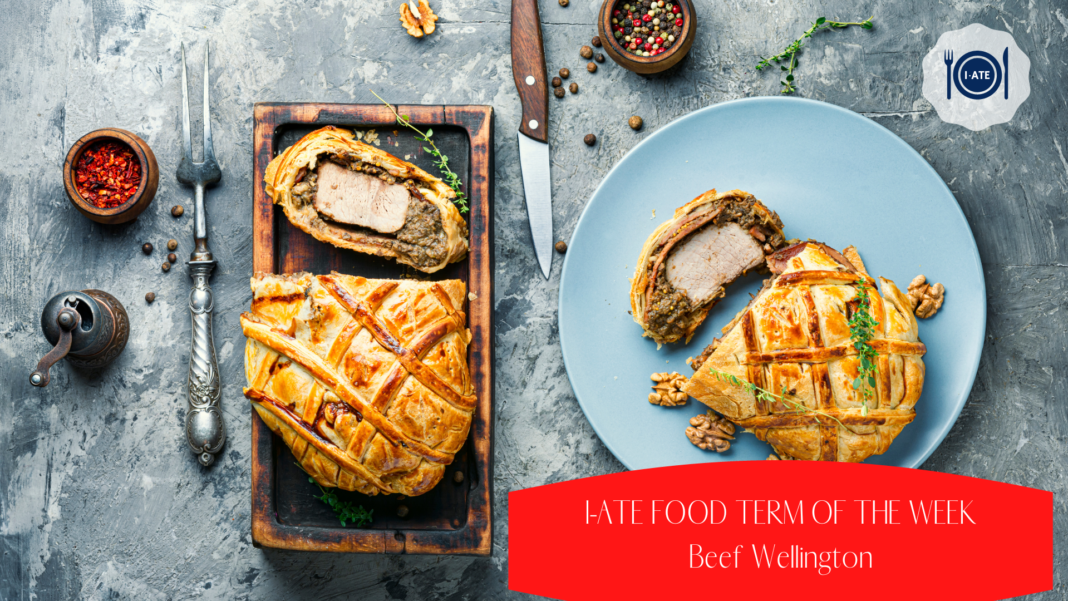Beef Wellington is one of the most well-known dishes of British origin. It consists of steak fillet, covered with pâté de foie gras and mushroom duxelles. The mixture is glazed, wrapped in a buttery puff pastry and then baked in the oven. It is accompanied with wine sauce.
Curious to learn why was the dish named Beef Wellington? Culinary historians claim that the dish was especially created in order to celebrate the victory of Arthur Wellesley (the 1st Duke of Wellington) during the Waterloo Battle on June 18th 1815. Wellesley defeated Napoleon Bonaparte the previous year and later on became Prime Minister. As a result, this pastry beef dish was (as rumour has it), named after him as a way to honour him. Other sources support that the origin of the dish dates back to Roman times, when a mixture of oil, water and flour was used in order to cover poultry and meat with the goal to keep the meat moist and tender.
What is strange though is that there is no reference to Beef Wellington in any cookbook before the 1970s! In fact, the most famous recipe of Beef Wellington is the one of Julia Child published in her book ‘’Mastering the Art of French Cooking, Volume 2’’.
The following assumptions exist regarding the name of the dish:
- Wellington the soldier had no specific obligations or concerns regarding the food that would be cooked and served to him. So it is believed that the dish was a result of his chef’s experimentation and imagination!
- Wellington loved the particular dish so much it had to be served at every dinner.
- This name was chosen because its form resembles the Wellington boot.
- The dish is actually of French origin.

How to prepare the Beef Wellington Step by Step
Although it seems like a simple dish, the recipe is not the easiest and requires following the steps accurately. Moreover, the choice and quality of the main ingredients plays a crucial role in the result. The main difficulty is in cooking the meat, which must be slightly fried in a pan with a bit of oil. The goal is to keep it juicy and not fully cooked and dry, as the inside part of the meat must remain with blood.
When the meat is ready, it must be covered with the cooked mushrooms paste, raw ham and occasionally mustard. Later on it should be wrapped in puff pastry and also brushed with eggs in order to obtain this dazzling golden colour. It is usually cooked at 200°C for only half an hour, but the duration of cooking varies depending on the fillet size and the oven you are using. When you take the dish out of the oven, let it rest before cutting it into equal pieces.
Ingredients
The following ingredients are the main ones. However, based on your personal preference, you can, of course, include additional ones!
3 tbsp olive oil 2 Portobello mushrooms (about 4 cups)
Salt/Seasalt
Black pepper
1 tsp thyme leaves
1 pound beef tenderloin
1 tbsp grapeseed oil
1 tbsp Dijon mustard
4 slices prosciutto
2 eggs yolks
Sheet puff pastry (thawed if frozen)
In total, you might need around two and a half hours to have this dreamy dish ready on your table, but the result will leave you undoubtedly pleased and can accompany your family Sunday gatherings!
References:
Foods of England – Beef Wellington. 2022. Foods of England – Beef Wellington. [ONLINE] Available at: http://www.foodsofengland.co.uk/beefwellington.htm . [Accessed 29 June 2022].
Gambero Rosso International. 2022. Beef Wellington: history and recipe – Gambero Rosso International. [ONLINE] Available at: https://www.gamberorossointernational.com/news/food-news/beef-wellington-history-and-recipe-of-an-iconic-dish/ . [Accessed 29 June 2022].
BBC Good Food. 2022. Beef wellington recipe | BBC Good Food. [ONLINE] Available at: https://www.bbcgoodfood.com/recipes/beef-wellington . [Accessed 29 June 2022].

Written by Ioanna Mavridou
Ioanna holds a Bachelor’s degree in Translation from the Ionian University in Corfu and has also studied her Master’s in Communication at Gothenburg University in Sweden. A digital communications enthusiast, she has completed a professional Social Media & Digital Marketing certification. She speaks Greek, English, Swedish, German and Russian. She is a Communications Trainee at the Terminology Coordination Unit of the European Parliament.

